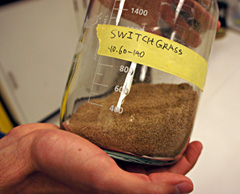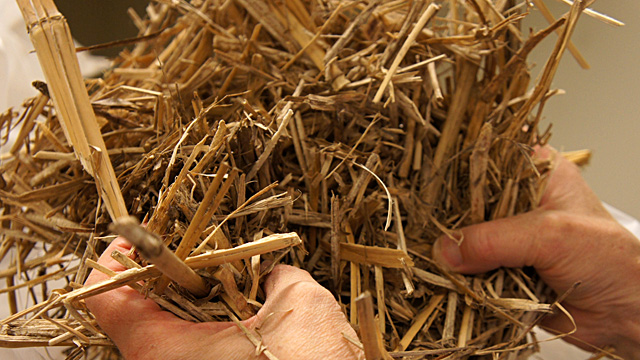“Corn is used extensively to feed animals. Corn is also used for some food as well, human consumption. So we want to be very careful about using corn itself,” says Jay Keasling, CEO of JBEI.
Engineering Microbes
JBEI was founded 5 years ago with a $125 million grant from the Department of Energy. It’s a partnership between UC Berkeley, Lawrence Berkeley National Lab and other groups with the mission of creating biofuels from plants that aren’t used for food – also known as cellulosic biofuels.
“Switchgrass is one that gets mentioned a lot,” says Keasling. “Switchgrass is a native to much of the Midwest. It grows without a lot of water and fertilizer.”
But unlocking the energy inside switchgrass is no easy task. “Plants have evolved to be tough. There are beetles, there are fungi that want to attack them all the time and get access to those sugars. So they’ve evolved defense mechanisms,” he says.

The first line of defense is like a barbed wire fence. Plants protect their sugars with a tough material called lignin. Keasling’s team breaks through it using a liquid salt solution.
Once it’s gone, the sugars still have to be broken down further. Most companies use industrial enzymes to do that. But this is where Keasling’s engineered e.coli comes in.
“What we’ve done is we’ve gone to places like the rainforest in Puerto Rico and to compost piles. We’ve sequenced the organisms that are breaking down that biomass and then cloned those genes into e.coli,” Keasling says.
The e.coli break down the sugars for themselves, saving an expensive step in the process. Using the sugars, they produce fuels. “Really they’re pooping out fuels,” says Keasling. “And these are fuels that can be put directly into gasoline engines, diesel engines or jet engines.” These microbes are an exciting breakthrough for Keasling, since they could help bring down the cost of production.
Federal Goals Scale Back
The federal government was once excited about cellulosic biofuels, too. In 2006, former President George W Bush included them in his State of the Union address, saying “we'll also fund additional research in cutting-edge methods of producing ethanol, not just from corn but from wood chips and stalks or switchgrass. Our goal is to make this new kind of ethanol practical and competitive within 6 years.”
Congress set up tax credits for cellulosic biofuels with a goal of seeing 500 million gallons produced in 2012. Since then, the industry has faced a harsh reality. The goal for next year has been cut back to just 12 million gallons.
“It was oversold. There was a lot of hype around it. It’s a tough problem. We can’t expect this to happen overnight,” says Keasling.
Keasling says if there’s anything that casts a shadow over biofuels, it’s the price of their biggest competitor. “If oil is under $100 a barrel, we’re not going to see many advanced biofuels on the market. They’re just not going to be able to compete. It’s virtually impossible,” he says.
Chris Somerville, director of the Energy Biosciences Institute (EBI), agrees. “The costs are still not where we need them to be.” EBI is also run by UC Berkeley and Berkeley Lab, among other collaborators. It was started with a $500 million grant from BP.
Like JBEI, EBI’s mission is also engineering cellulosic biofuels. They’ve developed specially engineered yeast that eat feedstocks like miscanthus. “It’s going to be another 10 years before it really scales up. And it’s not because there’s a big problem. It’s just takes time to build and bring online big industrial facilities that are first of a kind.”
Companies, including BP, are now building commercial-scale biofuel plants. But the science is evolving so quickly, Somerville says it’s hard for companies to commit. “If you’re a company that has to lay down some hundreds of millions of dollars for a new facility and you look around and everyday, there’s new advances, you think, well maybe I’ll wait until next week and build a better facility.”
Although some in Congress are impatient over the progress of advanced biofuels, Somerville is confident that it’s just a matter of time before the industry scales up. “What we’re really trying to do is change the world. And we have this huge entrenched energy sector. And so there’s lots of entrenched players that don’t welcome change.”
And he says, if we care about addressing climate change, we won’t be able to do it without remaking the fuels that go in our cars.


